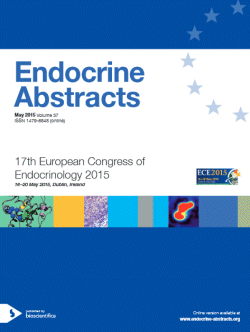Guided Posters
Adrenal (1)
ea0037gp.02.01 | Adrenal (1) | ECE2015
Steroid profiling by liquid chromatography–tandem mass spectrometry in patients with non-secreting adrenocortical adenomas and subclinical hypercortisolism
Di Dalmazi Guido , Fanelli Flaminia , Mezzullo Marco , Casadio Elena , Rinaldi Eleonora , Garelli Silvia , Vicennati Valentina , Pagotto Uberto , Pasquali Renato
ea0037gp.02.02 | Adrenal (1) | ECE2015
Urinary glucocorticoid metabolites and adrenal incidentalomas?
Brossaud Julie , Ducint Dominique , Corcuff Jean-Benoit
ea0037gp.02.03 | Adrenal (1) | ECE2015
Differential expression of the PKA subunits in adrenocortical adenomas
Weigand Isabel , Ronchi Cristina , Calebiro Davide , Rank Petra , Steinhauer Sonja , Beuschlein Felix , Allolio Bruno , Fassnacht Martin , Sbiera Silviu
ea0037gp.02.04 | Adrenal (1) | ECE2015
Mortality in patients with incidentally discovered adrenal adenomas: the experience of San Luigi Hospital
Reimondo Giuseppe , Coletta Marcella , Peraga Giulia , Pia Anna , Pellegrino Micaela , Massaglia Chiara , Zaggia Barbara , Cosio Paolo , Mbachu Elena , Borretta Giorgio , Terzolo Massimo
ea0037gp.02.05 | Adrenal (1) | ECE2015
Comparison between PET–CT and CT in the diagnosis of recurrence of adrenocortical carcinoma
Massaglia Chiara , Ardito Arianna , Zaggia Barbara , Basile Vittoria , Pelosi Ettore , Arena Vincenzo , Penna Daniele , Terzolo Massimo
ea0037gp.02.06 | Adrenal (1) | ECE2015
DNA methylation of FKBP5 and its relationship with hippocampal volumes in Cushing's syndrome patients
Resmini Eugenia , Santos Alicia , Aulinas Anna , Webb Susan , Gomez-Anson Beatriz , Cox Olivia , Lee Richard
ea0037gp.02.07 | Adrenal (1) | ECE2015
Urinary free cortisone as a potential biomarker in diagnosing patients with mild Cushing's syndrome
Trementino Laura , Concettoni Carolina , Martino Marianna , Marcelli Giorgia , Michetti Grazia , Boscaro Marco , Arnaldi Giorgio
ea0037gp.02.08 | Adrenal (1) | ECE2015
ACTH-ectopic syndrome in four patients, caused by phaeochromocytoma
Marova Eugenia , Rozhinskaya Ludmila , Kuznetsov Nikolay , Lapshina Anastasia , Voronkova Iya , Arapova Svetlana , Kolesnikova Galina , Krylov Vadim




